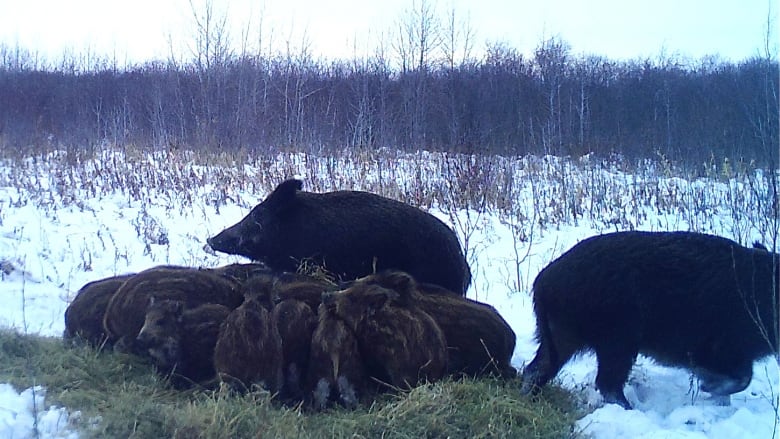Destructive, invasive wild pigs in Alberta have breached national park boundary for 1st time
Elk Island National Park near Edmonton has at least one herd

One of the most destructive and rapidly spreading invasive species on the continent has been found for the first time in a Canadian national park.
Wild pigs, which tear up landscapes and eat everything from roots to bird eggs to deer, are regularly present in Elk Island National Park the only fully fenced national park, located about 40 kilometres east of Edmonton, says Parks Canada.
"Public sightings and video sightings provided by landowners confirm that there is at least one sounder (a sow and piglets) in the region that is known to periodically come into the park," spokespersonJanelle Verbruggensaid.
"The physical evidence of rooting and public sightings suggest there may also be a second sounder."
Wild pigs were brought to Saskatchewan and Alberta in the 1990s to help farms diversify. Some escaped.
About half of Saskatchewan's 296 rural municipalities now have wild pigs, said Ryan Brook of the Canadian Wild Pig Research Project based at the University of Saskatchewan in Saskatoon. Their range spreads over nearly 800,000 square kilometres, mostly on the Prairies.
In Alberta, pigs have been spotted in 28 counties, said Perry Abramenko, who runs the Alberta government's pig removal program.
"The number of reports received is increasing every year," he said. "Nobody can come up with whether there's hundreds or thousands."
A hybrid of domestic pigs and European wild boar, the animals can reach well over 150 kilograms.
"They are the single most successful invasive large mammal on the planet," Brook said.

Their diet includes ground-nesting birds, their eggs and nestlings, small mammals, amphibians and even the occasional deer. They eat fruits, seeds, leaves, stems, shoots, bulbs, tubers and roots.
Pigs survive winter by heaping up cattails into burrows that Brook called "pigloos."
"They wallow in wetlands and tear them up to make their nests," hesaid. "They contaminate water with mud and pathogens, they destroy crops, they are a public safety hazard and they can transmit disease to humans, pets, livestock and wildlife."
A 2007 U.S. study suggested the pigs caused nearly $2 billion in annual damage. Another study found streams with pig populations had 40 times more E. coli bacteria than streams without.
Wild pigs 'a real challenge to capture'
Pigs are tough to get rid of, said Abramenko, who is working in the area just outside Elk Island.
"They're a real challenge to capture. They're very suspicious."
After Abramenko's team confirms a pig report, it sets up bait with a remotely operated camera. It can take weeks before a sounder is comfortable with returning to the bait site.
Once that happens, a corral with a remotely operated gate is erected. The team uses the camera to see when the entire sounder is inside, then they drop the gate.
"It's important to catch a whole sounder and not have any on the wrong side of the gate," Abramenko said. "Any that escape would become more trap-wise."
Hunting doesn't help solve the problem.
"As soon as there's any kind of hunting disturbance, they scatter. They infest new areas. They become nocturnal. They become real wary of humans, and any trapping efforts we put forward are diminished," Abramenko said.
Although Elk Island a small park featuring 194 square kilometres of boreal forest and wetlands is so far the only national park with wild pigs, others are likely to follow. Brook said Prince Albert National Park in Saskatchewan will probably be next.
"If there are no established wild pigs, there will be very soon," he said.
Verbruggen said Parks Canada is looking for help from the Alberta government to eliminate the pigs.
"Parks Canada looks forward to working together for the unified goal of preventing the establishment of wild boar in the area," she said.












_(720p).jpg)


 OFFICIAL HD MUSIC VIDEO.jpg)
.jpg)



























































































